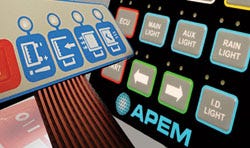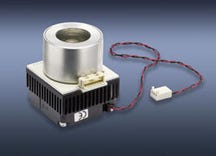Spotlight on Electronic Components 16453
December 8, 2011
 Customized membrane switches
Customized membrane switches
Apem Components Inc., a manufacturer of industrial switches and joysticks, offers a range of customized membrane switches for use in medical devices. Available in a variety of design, color, and illumination combinations, the ergonomically designed low-profile switches require little space and are thus adaptable to essentially any device design. Configured for either nontactile use or with tactile feedback using sound and light indication, the membrane switches feature flexible tail termination to facilitate direct connection to electronic equipment. Durable and environmentally neutral, they are suited for use under moderate to harsh conditions, including water immersion, electromagnetic interference, and exposure to ultraviolet radiation. The switches variously meet IP65, IP67, and NEMA4 standards.
Apem Components Inc.
HAVERHILL, MA
Inverters for medical diagnostic equipment
The low-profile SE/SE2 and compact E200II inverters from Endicott Research Group Inc. are vacuum-encapsulated to provide performance reliability and resistance to shock, vibration, and humidity. Used for powering cold-cathode  fluorescent lamp (CCFL)-backlit LCDs in such applications as medical diagnostic equipment, the inverters are suitable for single- and dual-lamp applications in which compact size, high efficiency, imperviousness to harsh environments, and reliability are critical. Their operating efficiency is typically between 80 and 85%. The inverters' customized magnetics are self-shielding, minimizing electromagnetic and radio-frequency interference. Because only the pins of the encapsulated inverters are exposed, the bottom of the PCB is the sole high-voltage surface, enabling the components to accommodate embedded designs. In addition, the low-profile version, measuring 0.420 in. high and suitable for one- or two-lamp configurations, provides up to 5 W of output power for single-CCFL backlights, while the compact series powers one or two CCFLs with as much as 8 W of output power.
fluorescent lamp (CCFL)-backlit LCDs in such applications as medical diagnostic equipment, the inverters are suitable for single- and dual-lamp applications in which compact size, high efficiency, imperviousness to harsh environments, and reliability are critical. Their operating efficiency is typically between 80 and 85%. The inverters' customized magnetics are self-shielding, minimizing electromagnetic and radio-frequency interference. Because only the pins of the encapsulated inverters are exposed, the bottom of the PCB is the sole high-voltage surface, enabling the components to accommodate embedded designs. In addition, the low-profile version, measuring 0.420 in. high and suitable for one- or two-lamp configurations, provides up to 5 W of output power for single-CCFL backlights, while the compact series powers one or two CCFLs with as much as 8 W of output power.
Endicott Research Group Inc.
ENDICOTT, NY Backlights for medical device equipment displays
Backlights for medical device equipment displays
Offering a range of backlights for medical device equipment, JKL Components Corp. supplies lamps to medical device OEMs for such applications as defibrillators, ventilators, and ECG equipment. Lamp assemblies designed for easy installation are available in single- and dual-lamp models, and the assemblies can interface with a variety of power sources and accessories. The lighting assemblies generally consist of the company's Compact Cold fluorescent lamps, which are available with diameters ranging from 2 to 8 mm and lengths ranging from 50 to 500 mm. Designed to meet specific application needs, the lamps are preassembled with the proper wire length, connector, and accessories, such as silicone end caps, rail insertions, and custom molded heaters. The company can also accommodate design changes and configuration updates.
JKL Components Corp.
PACOIMA, CA Miniature coin-cell holder
Miniature coin-cell holder
Part of the Mini line of coin-cell battery holders from Memory Protection Devices Inc., the BU2032SM-JJ-MINI-GTR holder is designed for use with CR2032 batteries. Its height of less than 2 mm, including the battery, saves almost 3 mm in board height, in comparison with the PCB-mounted holders typically used for this type of battery, according to the company. Height savings are achieved via a hole in the PCB surface in which the coin-cell holder is placed; side shoulders support its position. These shoulders, along with terminals at either end, make assembly quick and easy and keep the coin cell firmly seated in handheld and portable medical devices. The battery holder features gold-flashed, nickel-plated phosphor bronze contacts that resist corrosion, and the dual pressure contacts offer low electrical resistance and resistance to intermittent connections. In addition, the recurved positive contacts provide extra retention force to hold the coin cell. Capable of withstanding temperatures up to 280°C, the holder's liquid-crystal-polymer base piece tolerates the sterilization methods commonly used in medical device assembly, enabling it to tolerate lead-free reflow soldering.
Memory Protection Devices Inc.
FARMINGDALE, NY Rotary position sensor
Rotary position sensor
Suitable for use in medical device applications, the streamlined PST-360 through-hole rotary position sensor combines a through-shaft design with 360° absolute-position feedback in a thin package. Available from Piher International Corp., the small-form-factor sensor incorporates a proprietary ring magnet with a fully sealed Hall ASIC as the sensor element and a durable noncontact design that does not rely on gears or other interfacing parts. Offering electrical angles up to 360° with no dead band and linearity error as low as ±0.5%, the 9.8-mm-thick sensor has one moving part and includes encapsulated programmable electronics that can tolerate harsh environments. With a 37-mm body diameter and 50.0-mm mounting-hole spacing, the sensor can be integrated directly on existing shafts without the packaging issues that encoders or other through-shaft sensing devices typically involve, according to the company. The standard model features a rotor with a 14.05-mm-ID shaft, but custom rotor configurations that adapt existing OEM shafts to the standard sensor are also available.
Piher International Corp.
MUNDELEIN, IL
Optics module for lighting
The second-generation LEDgine LED light engine platform, specifically developed by Schott to provide more-efficient coupling of LED light into fiber-optic bundles, offers twice as much light as the original design did. Actively illuminating areas 3 to 6 mm in diameter and allowing continuous dimming between 100% and 0%, this optics module can be employed in medical device applications in which small-diameter light guides are commonly used. The encapsulated module contains white high-brightness LEDs and focusing optics that deliver the LED light to the light-guide input. It also features an integrated fan that supplies optimum cooling over a long operational lifetime. Customized coupling adapters and a small footprint facilitate incorporation of the module into OEM systems as well. Separate control electronics have also been optimized to lower energy consumption and enable portability when rechargeable batteries are used as the power source.
Schott North America Inc.
SOUTHBRIDGE, MA Medical interface contactor
Medical interface contactor
Originally used to test integrated circuits under harsh conditions in semiconductor applications, a high-density buckle-beam technology has been adapted for use in medical diagnostic equipment applications through the development of an interface contactor. This component, manufactured by Wells-CTI Inc., employs microfluidics and electronic detection technologies that enable it to perform molecular diagnostics-based testing of patient DNA samples. The equipment's connector module was jointly created by the contact system manufacturer and a partner company that produced the module's thermal, pneumatic, and mechanical interfaces. The module holds the disposable sample cassette while maintaining the temperature of the patient's fluid sample and providing electrical and pneumatic interfaces. The contact system also provides an electrical interconnect between the sensor system's PCB and the sample cassette, enabling molecular sample analysis.
Wells-CTI Inc.
VANCOUVER, WA
You May Also Like

.png?width=300&auto=webp&quality=80&disable=upscale)
